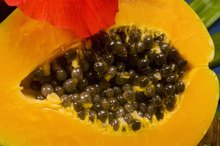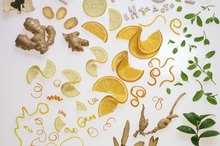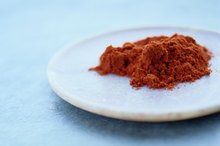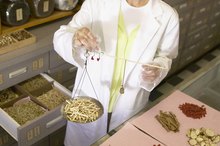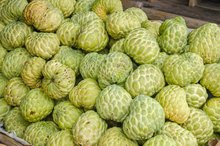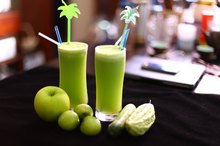Liver failure is a life-threatening condition that demands immediate medical care.
If you are experiencing serious medical symptoms, seek emergency treatment immediately.
If detected early, liver failure can often be treated and its effects reversed. Several traditional therapies use the extract of bitter melon to treat liver conditions successfully. However, consult with a physician before using alternative therapies for any medical condition.
Bitter Melon
Momordica charantia, commonly known as bitter melon or bitter gourd, is a tropical vine indigenous to Asia, Africa and the Caribbean. There are several varieties that differ significantly in form and bitterness of the fruit.
The plant contains several biologically active constituents, most notably momordicin I and II. Bitter melon is widely used as a digestive aid and for its antimalarial, antiviral, anti-helmintic, anti-diabetic and immunostimulatory effects.
- Momordica charantia, commonly known as bitter melon or bitter gourd, is a tropical vine indigenous to Asia, Africa and the Caribbean.
- The plant contains several biologically active constituents, most notably momordicin I and II.
Liver Failure
Benefits of Papaya Extract
Learn More
The initial symptoms of liver failure often resemble a large number of conditions. For this reason, liver failure may be initially complicated to diagnose. However, early symptoms often include nausea, fatigue, skin discoloration and diarrhea. As liver failure advances, the symptoms will become more serious, necessitating immediate medical care.
- The initial symptoms of liver failure often resemble a large number of conditions.
- For this reason, liver failure may be initially complicated to diagnose.
Literature Search for Bitter Melon Treatment for LIver Failure
In an article appearing in the August 2010 issue of the “Indian Journal of Biochemistry and Biophysics,” researchers assessed the anti-hyperglycemic and anti-oxidative potential of aqueous extracts of bitter melon in clinically induced diabetic rats 1.
Three groups of rats were used: a control group of healthy animals, a second group of diabetic rats receiving no treatment and a third group consisting of diabetic rats receiving treatment with bitter melon extract. Treatment of the test animals continued for 30 days and the researchers found significant improvements in the blood glucose levels to near normal.
Antioxidant activities and lipid metabolism levels were also measured in heart, kidney and liver tissues of all three groups. The study showed significant improvement in both the levels of reactive substances and antioxidant activities when bitter melon extract was given to the diabetic rats. The authors concluded that their results clearly demonstrate that Momordica charantia is not only valuable in controlling the blood glucose levels, but it also has antioxidant potential to protect vital organs, such as the liver, against damage caused by diabetes-induced oxidative stress.
- In an article appearing in the August 2010 issue of the “Indian Journal of Biochemistry and Biophysics,” researchers assessed the anti-hyperglycemic and anti-oxidative potential of aqueous extracts of bitter melon in clinically induced diabetic rats 1.
- The study showed significant improvement in both the levels of reactive substances and antioxidant activities when bitter melon extract was given to the diabetic rats.
Lipid Metabolism as a Sign of Liver Failure
Are Lemon, Ginger and Honey Good for the Liver?
Learn More
The January 2009 issue of the "International Journal for Vitamin and Nutrition Research" included an investigation on the protective effects of bitter melon extract on lipid metabolism in the liver of rats induced by immobilization stress 2. Researchers used varying oral dosages of subjected-to-immobilization stress for two hours over seven consecutive days. The rats were subjected to by keeping them in a cage where no movement was possible. After seven days, the test animals were killed and blood and liver tissues were collected to measure reactive substances indicative of liver failure.
The effects of the extract on lipid metabolism in the liver tissue of normal, control and rats pretreated with extract were evaluated. The study found that Momordica charantia inhibited stress-induced lipid metabolism as indicated by low levels of reactive substances in the liver homogenate from the treated and normal rats 3. The researchers concluded that this plant provides protection by strengthening antioxidant activity of enzymes in the liver and that inclusion of bitter melon extract in the daily diet would be beneficial for liver disorders.
- The January 2009 issue of the "International Journal for Vitamin and Nutrition Research" included an investigation on the protective effects of bitter melon extract on lipid metabolism in the liver of rats induced by immobilization stress 2.
- The effects of the extract on lipid metabolism in the liver tissue of normal, control and rats pretreated with extract were evaluated.
Liver Disease in Diabetes
The July 2009 edition of “La Clinica Terapeutica” published a study to evaluate the histological changes following administration of Momordica charantia in clinically induced diabetic rats 3. Eighteen rats were selected for this study and divided into three groups: non-diabetic, untreated diabetic and diabetic treated with bitter melon extract. Diabetes was induced in the experimental rats via intravenous injection. The extract was administered orally to the diabetic rats for 10 days and the liver tissues were collected for histological study.
The authors noted that the livers of the diabetic rats showed features of healing with administration of the extract. They concluded that bitter melon extract may be helpful in reversing the damage to the liver, as seen in diabetes mellitus.
- The July 2009 edition of “La Clinica Terapeutica” published a study to evaluate the histological changes following administration of Momordica charantia in clinically induced diabetic rats 3.
- The authors noted that the livers of the diabetic rats showed features of healing with administration of the extract.
Related Articles
References
- "Indian Journal of Biochemistry and Biophysics"; Anti-hyperglycemic and anti-oxidative effect of aqueous extract of Momordica charantia pulp and Trigonella foenum graecum seed in alloxan-induced diabetic rats; U. Tripathi et al.; August 2010
- "International Journal for Vitamin and Nutrition Research"; Bitter melon protects against lipid peroxidation caused by immobilization stress in albino rats; P. Chaturvedi; January 2009
- "La Clinica Terapeutica"; Clinical A histological study of the structural changes in the liver of streptozotocin-induced diabetic rats treated with or without Momordica charantia (bitter gourd); S. Teoh et al.; July 2009
- FoodData central. Bitter melon, cooked, fat not added in cooking. U.S. Department of Food and Agriculture. Updated 2019.
- Yin RV, Lee NC, Hirpara H, Phung OJ. The effect of bitter melon (Mormordica charantia) in patients with diabetes mellitus: A systematic review and meta-analysis. Nutr Diabetes. 2014;4:e145. doi:10.1038/nutd.2014.42
- Alam MA, Uddin R, Subhan N, Rahman MM, Jain P, Reza HM. Beneficial role of bitter melon supplementation in obesity and related complications in metabolic syndrome. J Lipids. 2015;2015:496169. doi:10.1155/2015/496169
- Sagkan RI. An in vitro study on the risk of non-allergic type-I like hypersensitivity to Momordica charantia. BMC Complement Altern Med. 2013;13:284. doi:10.1186/1472-6882-13-284
- Saad DY, Soliman MM, Baiomy AA, Yassin MH, El-Sawy HB. Effects of Karela (Bitter Melon; Momordica charantia) on genes of lipids and carbohydrates metabolism in experimental hypercholesterolemia: biochemical, molecular and histopathological study. BMC Complement Altern Med. 2017;17(1):319. doi:10.1186/s12906-017-1833-x
- Vitamin A fact sheet for health professionals. National Institutes of Health. Office of Dietary Supplements. Updated 2020.
- Sagkan RI. An in vitro study on the risk of non-allergic type-I like hypersensitivity to Momordica charantia. BMC Complement Altern Med. 2013;13:284. doi:10.1186/1472-6882-13-284
- Bitter melon. Memorial Sloan Kettering Cancer Center. Updated 2019.
- Bitter melon and diabetes. Diabetes.co.uk. Updated 2019.
- Bitter melon (momordica charantia). UIC Heritage Garden.
- Bitter melon. Tennessee State University. College of Agriculture, Human and Natural Sciences Ornamental Horticulture.
Writer Bio
Sam Lupica began scientific writing in 2007, specializing in physiology, toxicology and reproductive biology. He teaches chemistry and biology, and has published several journal articles in "Aquaculture Research" as well as informational articles in online publications. Lupica is finishing a Ph.D. in medical science and has a Master of Science in physiology and pharmacology from the University of Toledo College of Medicine.
